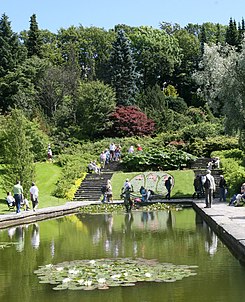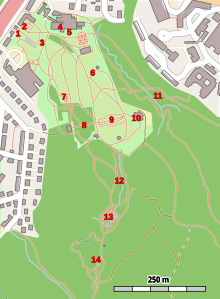Gothenburg Botanical Garden
| Göteborgs botaniska trädgård | |
|---|---|
| Park in Gothenburg | |

|
|
| The Spiegeldamm in the entrance area of the garden | |
| Basic data | |
| place | Gothenburg |
| District | Änggården |
| Created | 1923 |
| Surrounding streets | Carl Skottsberg's gata |
| Technical specifications | |
| Parking area | 175 ha |
Gothenburg's Botanical Garden (Göteborgs botaniska trädgård) is located in the Änggården district of the Majorna-Linné district in Gothenburg . The main part is 175 hectares and was inaugurated in 1923 in connection with the 300th anniversary of the city. Around 135 hectares in the adjacent nature reserve serve as an arboretum for the botanical garden . Unlike other botanical gardens in Sweden , it is not affiliated with the local university. In contrast, it was owned by the City of Gothenburg until 1998 and has belonged to the province of Västra Götalands län since then .
The garden plays a decisive role in the conservation of the Toromiro tree ( Sophora toromiro ), which was originally endemic to Easter Island .
The wood anemone was chosen as the symbol of the garden .
history
In connection with the 300th anniversary of Gothenburg, the city council decided to set up a botanical garden. The biologist and geologist Rutger Sernander was recruited for the planning and commissioned his colleague Carl Johan Fredrik Skottsberg to manage the work. Skottsberg was then the first director of the garden. The financial security of the 2.2 million crown project was guaranteed with money from a donation fund of the industrial magnate Charles Felix Lindberg. The property, on which the former Stora Änggården is located, belonged to the city before. The construction work began in 1916, but was delayed until after the 300th anniversary (1921) and so the inauguration did not take place until July 8, 1923.
In 1956 the garden received seeds from what is believed to be the last surviving Toromiro tree. The Norwegian naturalist and adventurer Thor Heyerdahl collected these on his Easter Island expedition (1955/56). It was not until three years after the arrival that attempts were made to grow plants from it. Five seeds were germinated the following year. Further plant specimens were obtained from cuttings, which were passed on to other botanical gardens, where they were raised and propagated. The Gothenburg specimen is now in the greenhouse of the Botanical Garden.
The park
The garden was laid out in a hilly area that rises towards the nature reserve. This made it possible to easily separate the individual areas. There is a large rock garden here with around 5000 different types of plants . In the 1950s, then director Gustaf Tor Nitzelius had the "Japan Valley" set up with plants imported from East Asia . In other areas, perennial plants , leeks and rhododendrons are presented.
About 4000 different species that cannot be cultivated in the open are in the greenhouse. This also includes Sweden's largest collection of orchids with around 1500 species.
building
- The administration building was designed by the architect Arvid Mattsson Bjerke . It opened in 1926 and in 1936 it was given a wing for the herbarium .
- The yellow villa of the original Stora Änggården manor from 1812 is above the greenhouse. It was renovated in 1912 under the direction of the architect Sigfrid Ericson and is now used as a staff apartment.
- The wooden boatswain's house or Blue House ( Blå huset ) from 1794 originally stood in the town's harbor area , roughly on the site of the America Terminal ( Amerikaskjulet ). After the dismantling in 1917, it was rebuilt near the bamboo garden in the botanical garden. Staff apartments are also set up here.
- The city architect Bernhard Carlberg designed the garden pavilion in the herb garden for his own garden in the late 18th century.
- The only building in the garden with a connection to Gothenburg University is the Botanical Institution. It was built until 1971 according to plans by the architects Stig Hansson and Walter Kiessling.
Reference literature
- Celander, Rigmor; Holmberg Mona, Celander Rigmor (1996): Nordiskt ljus och italiensk hetta: sommarblommor à la Göteborgs botaniska trädgård . Gothenburg: Göteborgs botaniska trädgård. ISBN 91-87068-26-5
- Neuendorf, Magnus; Johansson Ingemar (botanist), Erlandsson Marianne (2002): Halva världens växter: en bok om växthusen i Göteborgs botaniska trädgård . Gothenburg: Göteborgs botaniska trädgård. ISBN 91-87068-34-6
- Hvar 8 day: illustreradt magasin , [October 7, 1923 - September 28, 1924], DF Bonnier, Göteborg 1924, p. 614ff
Web links
- Official website (Schw.) / (Engl.)
Individual evidence
- ↑ Naturvårdsenheten, Västra Götalands län
- ↑ Göteborgsbilder 1850-1950 , red. Harald Lignell, Björn Harald, Axel Möndell, Doug. Wallhäll, Bokförlaget Nordisk Litteratur, Göteborg 1952, p. 454
- ↑ Göteborgs municipal calendar 1938 , red. Werner Göransson, utgiven av Göteborgs stads statistiska byrå, Göteborg 1938, p. 196
- ↑ B. Aldén: Le Toromiro, l'arbre des Pascuans fleurit toujours en Suéde, in Nouveau regard sur l'Île de Pâques, Chapitre IX: Histoire de la végétation de l'Île de Pâques, Rapa Nui , 1982, p. 119 -120
- ↑ Byggnader i Göteborg: en guide till 1900-talsarkitektur , Claes Caldenby, Matts Heijl, Eva Jönsson, Jaan Tomasson, Sections för arkitektur, Chalmers Tekniska Högskola 1979, p. 211
Coordinates: 57 ° 40 ′ 58.4 " N , 11 ° 57 ′ 1.4" E










